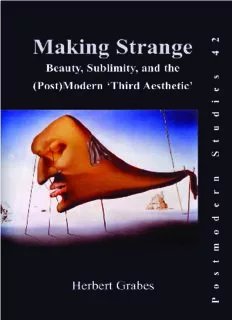
Making strange : beauty, sublimity, and the (post)modern 'third aesthetic' PDF
Preview Making strange : beauty, sublimity, and the (post)modern 'third aesthetic'
Making Strange Postmodern Studies 42 Series edited by Theo D’haen and Hans Bertens Making Strange Beauty, Sublimity, and the (Post)Modern 'Third Aesthetic' Herbert Grabes Amsterdam - New York, NY 2008 Cover image: Salvador Dalí, Schlaf (50 x 77 cm), ca. 1937 © 2004 A. Francke Verlag Tübingen und Basel English translation by Marc Colavincenzo from Einführung in die Literatur und Kunst der Moderne und Postmoderne: Die Ästhetik des Fremden (Tübingen & Basel: Francke, 2004), with further editing by Gordon Collier. Cover design: Aart Jan Bergshoeff The paper on which this book is printed meets the requirements of “ISO 9706:1994, Information and documentation - Paper for documents - Requirements for permanence”. ISBN-13: 978-90-420-2433-5 ©Editions Rodopi B.V., Amsterdam – New York, NY 2008 Printed in The Netherlands Table of Contents List of Colour Plates ix Introductory Note xi 1 The Aesthetic of the Strange Not Beautiful, but Strange 1 Not Sublime, but Strange 7 The Aesthetic of the Strange 11 2 The Strange Art and Literature of Modernism Radical Strangeness in Early Modernism 19 1 ALTERNATIVE REALITIES PRESENTED IN UNUSUAL WAYS 22 The Unfamiliar Metaphors of Expressionism; The Strange Objectivism of the Cubists; The Estranging Montage of the Heterogeneous in the Collage; The Wholesale Break with Tradition: Abstract Art; The Provocative Expansion of the Definition of Art: Dada and Ready-Mades; The Strange World of Surrealism; Stream of Consciousness 2 THE WIDENING OF EXPERIENCE 43 Experiments with Form and New Modes of Perception; The Need for Explanatory Theory 3 THE UTOPIA OF RENEWAL 46 The Renewal of Art; The Renewal of Literature Varieties of Strangeness in the Later Phase of Modernism 54 1 THE INTENSIFICATION OF EARLY MODERNIST TENDENCIES IN ART 55 Abstract Expressionism; The Elite Artistic Status of the Trivial; Kinetic Art and Op Art 2 THE CONTINUATION AND INTENSIFICATION OF LITERARY CONCEPTS 62 The Theatre of the Absurd and the ‘nouveau roman’; German Followers of Brecht, Concrete Poetry, American Anti-Formalism of the Beat Generation 3 The Strange Art and Literature of Postmodernism New Radicalness in the Early Phase of Postmodernism 67 1 THE RELATIVIZATION OF THE FAMILIAR 69 Irony, Parody, Travesty; The Mixture of Styles and Genres; The Expansion of the Realm of Art and Literature 2 THE CELEBRATION OF TRANSIENCE AND THE ARBITRARY 81 The Shift From the Work to Process; The Construction of the Contingent and Arbitrary; The Reduction to Pure Possibility 3 THE HORROR GAME 98 The Strange as Subtle Difference in the Later Phase of Postmodernism 102 1 VARIATION AND INTERTEXTUALITY 105 “Neo” Art and the Post-Avantgarde; Realist Narrative Made Strange; The Return to Earlier Dramatic Genre Conventions; The Aesthetic of Subtle Difference 2 RECOURSE TO THE NEW MEDIA AND FOREIGN CULTURES 115 New Media and Foreign Cultures in Art; New Literary Utopias and Cultural Hybrids 3 THE COMPETITION OF THE SIMULTANEOUS 119 4 The Aesthetic of the Strange as the Aesthetic of Modernism and Postmodernism 125 5 Theoretical Foundations of the Aesthetic of the Strange 133 Disinterested Pleasure; Universal Pleasure and the Free Play of the Imagination; Aesthetic Processes; The Release of the Imagination Through Boundedness; The Beautiful, The Ugly, and the Alienating; Kant’s “Aesthetic Ideas”; Beautiful Art, Nature, and Alienating Art; The Beautiful as a Symbol of the Morally Good and the Strangeness of Art as a Symbol of the Unstable Distinction Between Subject and ‘World’, Culture and ‘Nature’ Works Cited 165 List of Colour Plates (after page 132) Figure 1 Ernst Ludwig Kirchner, Liegender blauer Akt mit Strohhut [Re- clining Blue Nude with Straw Hat] (68x72 cm; oil on cardboard, 1909). Sammlung Franz Burda, Offenburg. Figure 2 Georges Braque, Violin et palette [Violin and Palette] (91.7x42.8 cm; oil on canvas, September 1909). Solomon R. Guggenheim Museum, New York. Figure 3 Pablo Picasso, Verre et bouteille de Suze [Glass and Bottle of Suze] (65.4x50.2; collage: pasted paper, charcoal and goauche, Novem- ber/December 1912). Washington University Gallery of Art, St. Louis, Missouri. Figure 4 Wassily Kandinsky, Schwarze Linien Nr. 189 [Black Lines No. 189] (129.5x130.2 cm; oil on canvas, December 1913). Solomon R. Guggenheim Museum, New York. Figure 5 Marcel Duchamp, In Advance of the Broken Arm (121x35.5 cm; readymade: snow shovel, wood, and galvanized iron, 1915). Indiana University Art Museum, Bloomington, Indiana Figure 6 Salvador Dalí, El sueño [Sleep] (51x77; oil on canvas, 1937). Pri- vate collection. Figure 7 Mark Rothko, Untitled (183x153 cm; oil on canvas, 1959). National Gallery of Art, Washington, D.C.
Description: